 Cooper's hawk and its eternal question: Can I eat that?
Cooper's hawk and its eternal question: Can I eat that?
Birdchick Podcast #31 Duck Stamps, Warbler Madness and Window Collisions
Birder's got served by this sign in Ohio. Many birders don't purchase Duck Stamps because "they don't want to be lumped in with hunters" despite the fact that 98% of the money from the purchase of a Duck Stamp goes to habitat acquisition for breeding, migration and wintering grounds.
Cuyahoga Falls City Councilman Jerry James tries to legislate keeping bird feeders clean.
A unique and mysterious guinea-pig-sized rodent, not seen since 1898 despite several organized searches, bizarrely showed up at the front door of an ecolodge at a nature reserve in Colombia, South America. The magnificent red-crested tree rat (Santamartamys rufodorsalis), stayed for almost two hours while two research volunteers took the first photos ever of a creature the world thought would never be seen again.
Deer Eats A Baby Bird
Yikes, this video may not be for the squeamish. It's not bloody but there's no doubt what this deer does. They're not just herbivores. [youtube]http://www.youtube.com/watch?v=sQOQdBLHrLk&feature=player_embedded[/youtube]
Thank you, Matt, for sending this...I think.
Podcasting This Week
Just a quick heads up about the podcast this week. It looks like we'll only be able to record one and we will record it Tuesday night and it will be up Wednesday morning. I'm right in the middle of my crazy spring work schedule. As I type this, I'm in Utah and won't be home until tonight and Non Birding Bill also has a Theatre Arlo gig tonight. But we'll get one in before I head to Detroit Lakes on Thursday and this week it will be longer. In the meantime:

I'll leave you with a white-faced ibis foraging at Bear River Migratory Bird Refuge in Utah. This one did not get nailed by a peregrine falcon.
Random Solitary Sandpiper
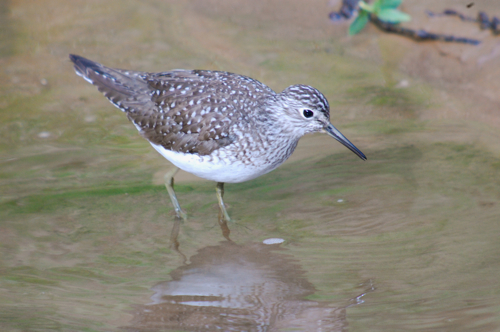 Solitary sandpiper lurking around Mr. Neil's creek.
Solitary sandpiper lurking around Mr. Neil's creek.
Sweet #Birding Camps For Kids
The American Birding Association still has space left for kids on their cool camps this summer...if they'd allow adults who act like kids, I'd LOVE to go on one of these. Check 'em out and if you know a kids who would love to do this, try to help get them there: Project Puffin Hog Island Audubon Camp: Coastal Maine Bird Studies for Teens Jun 19-24, 2011 Audubon's venerable camp in coastal Maine, now co-sponsored with ABA, includes field identification, bird song recognition, conservation practices, and the opportunity to observe Audubon's seabird conservation field research.
ABA Young Birder Camp Colorado June 25-July 2, 2011 This repeat of last year's wildly successful camp will feature Jennie Duberstein, Bill Schmoker, and Liz Gordon as new counselors and incredible field trips from mountains to plains with Colorado experts like Birding editor Ted Floyd and Winging It editor Bill Maynard.
ABA Young Birder Camp Lower Rio Grande Valley July 9-16, 2011 This year's traveling camp takes us to the Texas tropics with field trips from Zapata to South Padre Island, all along the Rio Grande. Known to birders (and butterfliers) worldwide, "the Valley" offers incredible species diversity with camp programs and field trips hosted by some of the best known regional experts.
Victor Emanuel Nature Tours' Camp Tejano Jul 8-20, 2011 This ABA co-sponsored camp offers a unique summer program centered on the wildlife-rich ecosystems of the Texas Hill Country, Big Bend National Park and the Davis Mountains.
Seattle Audubon Society's Cascades Bird Banding Camp Aug 15-19, 2011 This co-sponsored camp will focus on the basics of net placement, extraction & handling, aging & sexing, with special emphasis on molt to age birds.
Visit the ABA site for camp contact details.
Oh Snap!
 I think this is something Non Birding Bill and I will address on the next podcast but check out this photo that Paul Baicich sent out to a listserv intended for promoting the Duck Stamp to birders. He wrote that it was seen in northwest Ohio during the "Biggest Week in American Birding" along State Route 2, west of Ottawa NWR and a few miles from Magee Marsh WA.
I think this is something Non Birding Bill and I will address on the next podcast but check out this photo that Paul Baicich sent out to a listserv intended for promoting the Duck Stamp to birders. He wrote that it was seen in northwest Ohio during the "Biggest Week in American Birding" along State Route 2, west of Ottawa NWR and a few miles from Magee Marsh WA.
Baby Owls Branching Out
I'm in the midst of my busies month. If I'm not at the National Park Service engaged in ranger work, I'm on the road at a bird festival, birding the crap out of whatever state I'm in. It's a horrific schedule but it's loads of fun. And at the end of the month of May, I get a weekend off to celebrate my wedding anniversary with Non Birding Bill (we'll be on year lucky 13--boy, why did I think it would be a good idea to get married in May?). A friend of mine who is new to birding asked if I'd like to go out next week. My first answer was that I was too busy. But then I saw on Tuesday that it was supposed to be 80 degrees and I just couldn't say no. So we did some birding near my apartment. It's warbler season and they are dripping off the trees. The few days I was home, I had a golden-winged warbler outside my bedroom window ever morning!
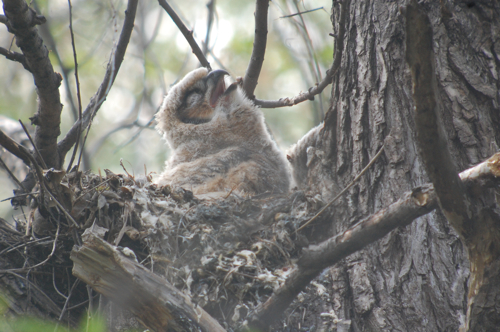
I showed him the owl nest and boy the two young owls were panting like crazy. Birds don't sweat like humans and pant like dogs when their hot. The young owls still have some of their thick down that protects them in snow storms when they hatch earlier. Doesn't it look like it's saying, "Oh man, I'm so hot, ugh."

I didn't see either adult and figured that since the young were so large, they were tucked in a nearby conifer for shade from the warm sun. As I looked at the nest from this angle, I realized how trashed it is. Check out these photos from an earlier entry when the female was still incubating. Note how the nest material was all the way to to the stick. In the above photo, it's well below that now. I thought to myself that these owls have to be in the brancher phase. That's when they are still downy but their feet are very strong and they begin to venture out of the nest. The young birds can even be blown out of the tree, yet their feet are strong enough to enable them to climb back up.
It looks like they have some feather development on their wings and back. I got confirmation on this a few days later from another nearby resident who has been watching the nest and he confirmed that babies had crawled out and were on branches 10 feet from the nest. Our little guys grow up so fast.
Solving the 2 Queen Problem
Remember how we had 2 queen in one of our Russian hives? Well, they seemed to have sorted things out and the queen with the large white dot killed the newer queen with the small white dot. So, that solved itself. However, one of our other Russian hives is queenless--that queen was alive when we installed it, she was the most active queen we had. But there are no eggs and after searching for her three times we've concluded that something happened to her.
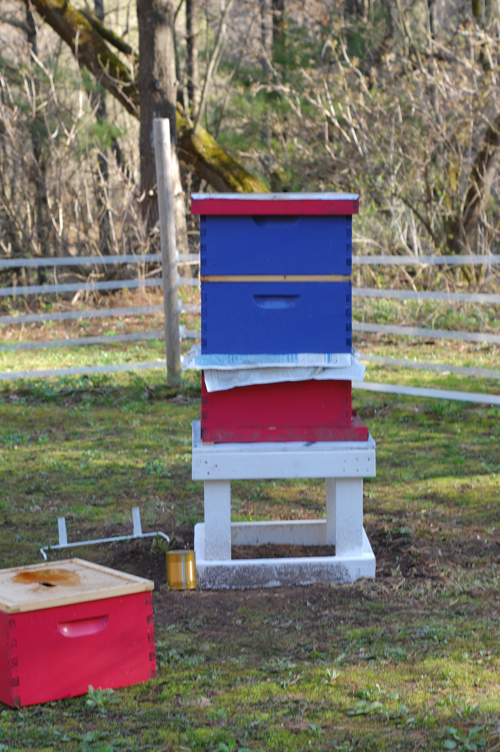
So, we decided to combine the queenless bees to the colony with one killer queen via the newspaper method. The box with the queen and colony is on the bottom. We put a piece of newspaper on top, then the box from the queenless colony above the newspaper. Above that is a box with a feeder pail. The idea is that the bees from the queenless colony and the box with the queenright colony will chew through the news paper over the next day or two and in that time the queenless bees will absorb the queens pheromone and everyone will get along. So, we've gone from seven hives to six but it's all good.
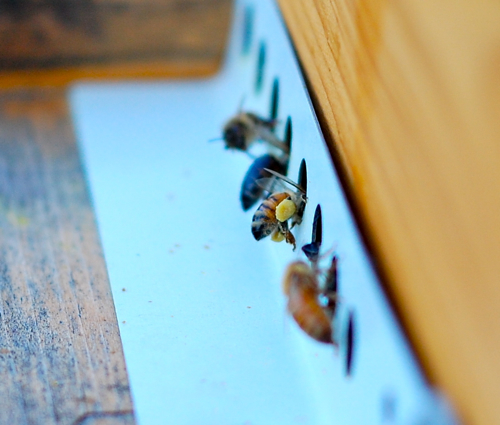
Our bees are ignoring the pollen patties that we provide as a supplement and seem to be hard at work gathering pollen from dandelions. Many were returning with thick yellow baskets on their legs--yay!
Year of the Sora
Someone asked on Twitter if this was the year of the sora because the seem to be EVERYWHERE.
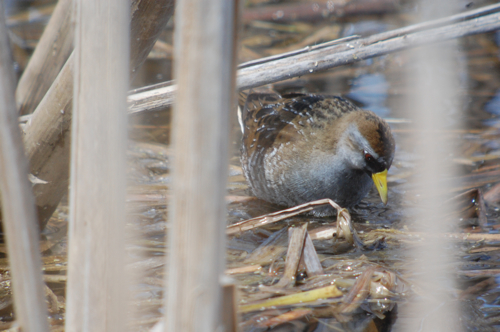
This is a sora that was very cooperative at the Minnesota Valley National Wildlife Refuge. I took this before I left for Horicon. I was walking by the Bass Ponds and I could hear several soras when I noticed this bird out and about in the open, not skulking among the vegetation like most soras do.

Here is where the sora was in relation to my scope. Here's what the sora sounds like. Here are some more calls on the Cornell All About Birds page.

Horicon Marsh was loaded with them too. I didn't get any photos of the little water chicken, but I heard them every stop I made that had any sore of marsh. Right now I'm in Utah for the Great Salt Lake Bird Festival. When I arrived, I went straight from the airport for some birding at Bear River Migratory Bird Refuge and it was sora city there as well. I don't remember hearing so many soras all the time--I'll take it. Must mean they found some great breeding habitat and great places to over winter the last few years.
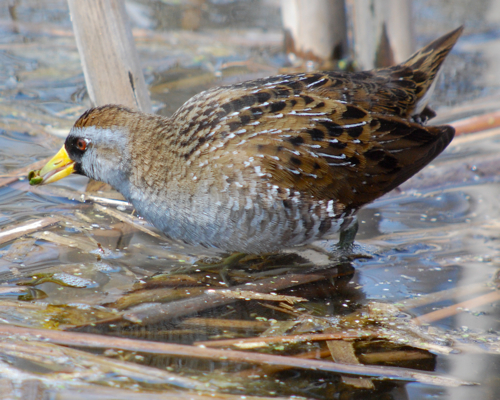
They eat vegetation and invertebrates. This bird was too fast for me to capture it, but I watched it down a few small snails including shell. I wondered if this was a female, snail shells provide calcium for egg laying.

Those these birds are timid, the curve of the beak always gives them a contented look.

Keep your eyes and ears open for these mysterious little water chickens.

